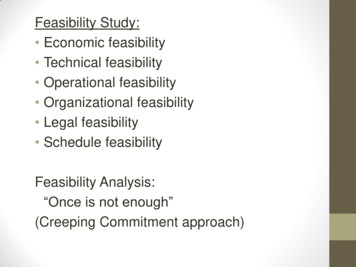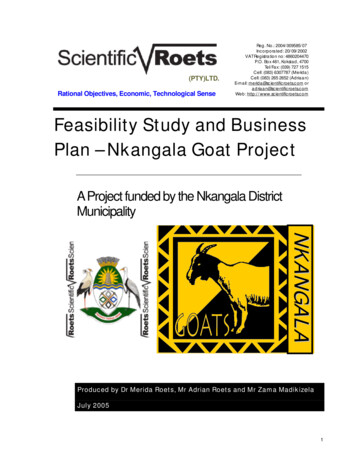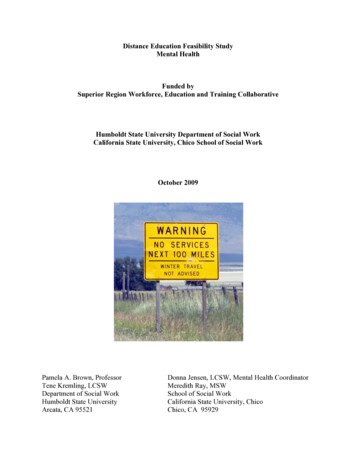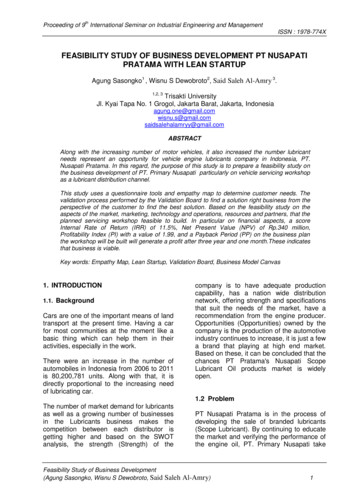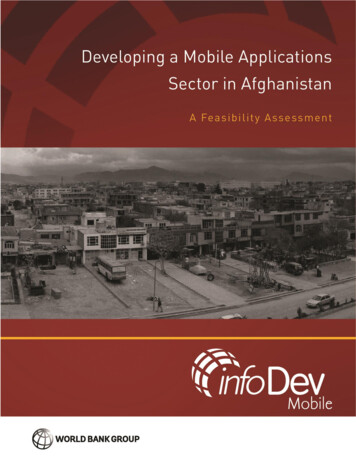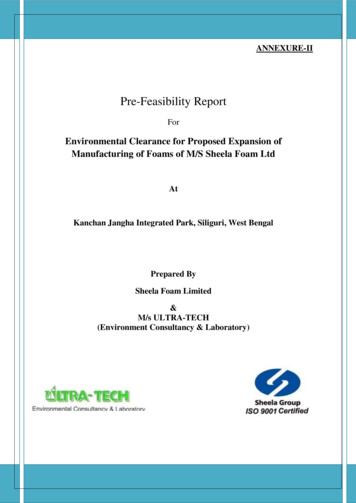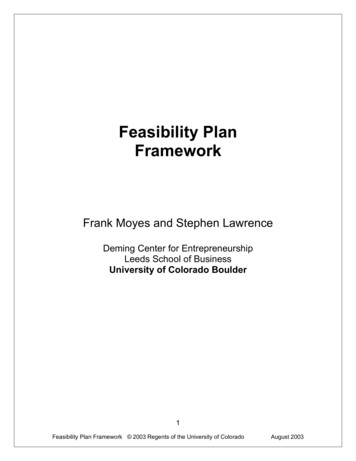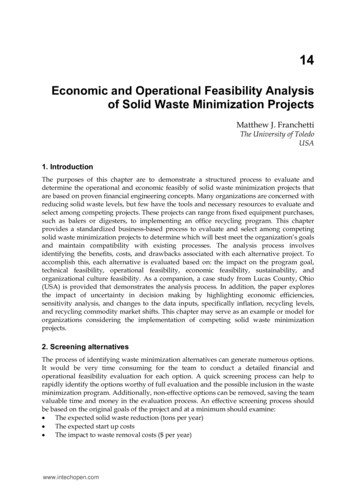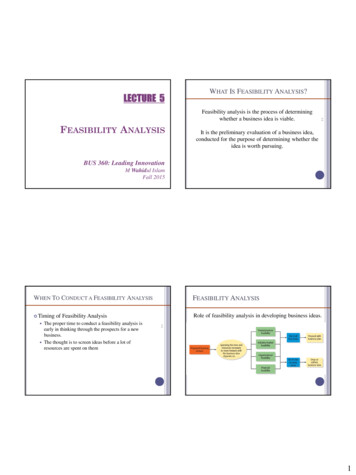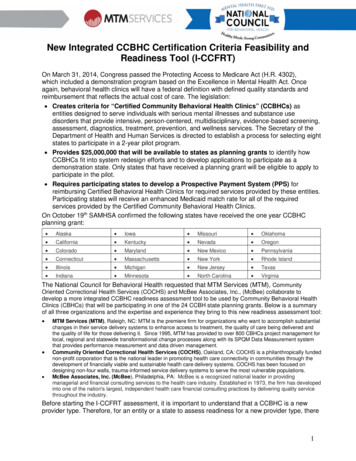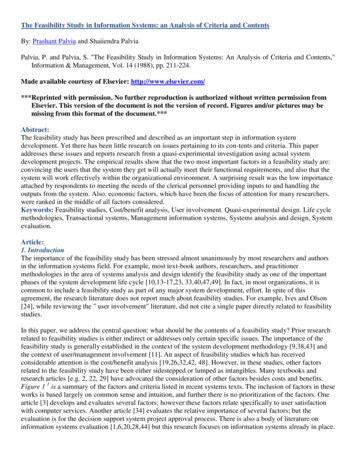
Transcription
The Feasibility Study in Information Systems: an Analysis of Criteria and ContentsBy: Prashant Palvia and Shaiiendra PalviaPalvia, P. and Palvia, S. "The Feasibility Study in Information Systems: An Analysis of Criteria and Contents,"Information & Management, Vol. 14 (1988), pp. 211-224.Made available courtesy of Elsevier: http://www.elsevier.com/***Reprinted with permission. No further reproduction is authorized without written permission fromElsevier. This version of the document is not the version of record. Figures and/or pictures may bemissing from this format of the document.***Abstract:The feasibility study has been prescribed and described as an important step in information systemdevelopment. Yet there has been little research on issues pertaining to its con-tents and criteria. This paperaddresses these issues and reports research from a quasi-experimental investigation using actual systemdevelopment projects. The empirical results show that the two most important factors in a feasibility study are:convincing the users that the system they get will actually meet their functional requirements, and also that thesystem will work effectively within the organizational environment. A surprising result was the low importanceattached by respondents to meeting the needs of the clerical personnel providing inputs to and handling theoutputs from the system. Also. economic factors, which have been the focus of attention for many researchers.were ranked in the middle of all factors considered.Keywords: Feasibility studies, Cost/benefit analysis, User involvement. Quasi-experimental design. Life cyclemethodologies, Transactional systems, Management information systems, Systems analysis and design, Systemevaluation.Article:1. IntroductionThe importance of the feasibility study has been stressed almost unanimously by most researchers and authorsin the information systems field. For example, most text-book authors, researchers, and practitionermethodologies in the area of systems analysis and design identify the feasibility study as one of the importantphases of the system development life cycle [10,13-17,23, 33,40,47,49]. In fact, in most organizations, it iscommon to include a feasibility study as part of any major system development, effort. In spite of thisagreement, the research literature does not report much about feasibility studies. For example, Ives and Olson[24], while reviewing the " user involvement" literature, did not cite a single paper directly related to feasibilitystudies.In this paper, we address the central question: what should be the contents of a feasibility study? Prior researchrelated to feasibility studies is either indirect or addresses only certain specific issues. The importance of thefeasibility study is generally established in the context of the system development methodology [9,38,43] andthe context of user/management involvement [11]. An aspect of feasibility studies which has receivedconsiderable attention is the cost/benefit analysis [19,26,32,42, 48]. However, in these studies, other factorsrelated to the feasibility study have been either sidestepped or lumped as intangibles. Many textbooks andresearch articles [e.g. 2, 22, 29] have advocated the consideration of other factors besides costs and benefits.Figure 1 1 is a summary of the factors and criteria listed in recent systems texts. The inclusion of factors in theseworks is based largely on common sense and intuition, and further there is no prioritization of the factors. Onearticle [3] develops and evaluates several factors; however these factors relate specifically to user satisfactionwith computer services. Another article [34] evaluates the relative importance of several factors; but theevaluation is for the decision support system project approval process. There is also a body of literature oninformation systems evaluation [1,6,20,28,44] but this research focuses on information systems already in place.
2. Study GoalsIn order to identify the issues related to the feasibility study, we first examine the definition of a feasibilitystudy. A commonly accepted definition of a feasibility study/analysis is:A feasibility study/analysis aids in evaluating the suitability of a single or multiple proposed systemsolution(s) to an identified business problem according to a set of criteria.The set of criteria may be explicitly or implicitly applied in the evaluation of the system proposals. It is worthnoting that the feasibility study itself is generally prepared by the system analysts/ technical staff with possibleassistance from the user group. The actual evaluation is made by the user management and/or top management,with assistance from systems analysts/technical staff. Thus the feasibility study (including its preparation andevaluation) offers an excellent vehicle for achieving user involvement and commitment, as has been stronglyrecommended for successful system development [e.g. 11. 24].
The set of criteria (termed criteria factors or factors) by which the proposed systems solutions are to beevaluated determine what should be included in the feasibility study. It should, at least, address the criteriafactors in order of their relative importance. In addition to these, the study may address other factors for"informational" reasons. However. addressing the criteria factors is critical for the preparation of the feasibilitystudy. Therefore, in the spirit of the Parets distribution (80-20 rule), we concentrate on the contents of thefeasibility study relative to the criteria factors.The following objectives were established for our research:A. Identify and prioritize the set of criteria by which the feasibility study should examine the systemproposal(s).B. Identify possible differences in the evaluation criteria and their importance from the perspective ofdifferent stakeholders (user vs analyst) of the system under development.C. Identify possible differences in the evaluation criteria and their importance relative to the type of systembeing developed.D. Assess the overall adequacy of the feasibility study, as well as the adequacy from the analyst's and ,user'sviewpoints.3. Research MethodologyThe research methodology was quasi-experimental. An empirical opinion-based study of professionals in thefield would have yielded less-than-accurate "perception" data about the issues. A tightly controlledexperimental study was deemed impractical because of the enormous effort needed in its preparation,administration and evaluation. Instead, we conducted semi-controlled experiments, where data was collectedfrom analysts and users at the time of presentation of the feasibility study for actual system developmentprojects.The research was conducted in a two-year period, from 1983 to 1985, at two major American universities.2 Theauthors taught project-oriented systems analysis and design classes at these universities. Each class was divided
into teams of three to five students. Each team worked on developing (i.e. defining, designing, andimplementing) a real business system for industry or academia (as opposed to working, on case studies). Someexamples of the business systems developed by the teams are listed in Exhibit 1.A system development life cycle (SDLC) model was followed in building the system. The analysis and designpart included the following phases/ documents:A.Investigating Proposal/Problem StatementB.Requirements StudyC.Alternative System ProposalsD.Feasibility Analysis/StudyE.Detailed System DesignF.Draft User Manual.Similar life cycle methodologies are presented in many references [e.g. 8, 18, 30, 31, 45, 49]. However, thetiming of the feasibility study is not very well defined in the above literature. We chose to perform this studyafter the proposals reached a reasonably concrete form. Our reasons for doing so are best expressed in thefollowing [12]"Management would like to see the cost-benefit study completed during the survey phase. . But thesober fact is that you cannot analyze the trade-offs until you have something to analyze. The idea ofperforming an early cost-benefit is largely a fiction."The use of student analysts Mowed control (generally a requirement for a scientific study) on the systemdevelopment process. There may be differences between student and practitioner analysts, but we believe thatour results have field relevance for the following reasons: the student analysts were mostly seniors and MISmajors, had several data processing and MIS courses prior to taking this course, were preparing for a career ;systems analysis and design, and the applications developed by them were real business applications.Part of the experimental control was exercised in the preparation of the feasibility studies. The criteria factors,as specified by different authors3 in Figure 1, are similar to those presented in many books [e.g. 35]. Eachanalyst team was instructed on the definition and purpose of each factor, and was required to prepare thefeasibility study in accordance with the criteria factors. They were asked to address each factor in the context oftheir own project. Thus we had some control over the process, as each study was prepared according to thecriteria guidelines, which were fully explained to the analysts.There were nine major criteria factors used for evaluation of feasibility studies. While most factor.; are selfexplanatory; two need explanation. "Ability to meet system --requirements" refers to how well and howcompletely a proposed system alternative meets the functional requirements. "Operational factors" refer to theability of the proposed system to work successfully in the operating environment of the organization. Somecriteria factors were split into sub-categories (as shown by the indentation in Figure 1). For example, peoplefactors were split into primary and secondary users, DP operations, and DP systems. The primary users arethose for which the system is designed, while the secondary users are personnel in the user department doingclerical processing of the input to and output from the system [5]. Data was collected directly on the majorfactors as well as subfactors; subsequent analysis will report data on all nineteen factors.
Once the feasibility study had been completed, it was submitted to the user management for review. After this, aformal presentation was made by the analysts to the users, at which point clarifications/explanations about thecriteria factors were presented. After the alternative system proposals were evaluated and an alternative wasselected for implementation, a survey instrument was administered, both to the analysts and users. Thequestionnaire4 included questions on the relative importance of the criteria factors of the feasibility study. Theimportance of each factor was evaluated on the following 5-point Liken scale:ImportantveryNot importantAt allIn a similar manner, .the adequacy of each factor addressed in the feasibility study was evaluated as follows:In addition, questions about the profile of the respondent were included. The questionnaire also containedquestions on other issues related to feasibility studies. Some were included for the sake of testing theconsistency of the responses.4. ResultsThere were sixty-eight responses to the questionnaires. The profile of the respondents and the systems isreported in Figure 2. Respondents were either clients (users) or analysts. Their orientation to business/dataprocessing was measured and accordingly the respondents are grouped as having more business orientation,more DP orientation or an even balance. The systems being developed had features of "automation of manualoperations (i.e., transaction processing)" and "information providing (i.e., MIS)". The systems were grouped astransactional, MIS, or both.The importance ratings of the criteria factors were analyzed first on an overall basis. Next differences in theimportance ratings for particular subgroups were considered. Finally, the adequacy of presentation ratings of thefactors, overall, by the clients, and by the analysts, were compared.Each factor and subfactor was ranked on its importance in feasibility assessment. A higher rating indicatedgreater importance. The average rating for each factor was computed. Based on the average ratings, the majorfactors and subfactors are prioritized as shown in Figure 3. Figure 4 lists the percentage of respondents thatconsider a factor to be important (those giving it a rank of 3 or 4).
The factors rated highest are operational ones, and the system's ability to meet the functional requirements. Thenext most important factor is the overall impact of the proposed system on the organization as a whole followedby people factors and economic factors. Most prior work emphasizes only the cost-benefit portion the feasibilitystudy; but in our results, this is in the middle, with management support and technical lower. Finally the lowestrating is for security and legal considerations.In order to test the consistency and validity of the responses and to give the respondents an opportunity toexpress their own criteria, they were further asked to list the three most important and the time least importantcriteria. These rankings were generally consistent with our results. Some new criteria were expressed, e.g. "easyto use," " timely" and "automated"; these could be classified as "operational factors".The criteria-importance data was also classified along three dimensions: client (user) vs. analyst rating (Figure5), business vs. data processing orientation of the respondent (Figure 6), and the type of the system beingdeveloped, i.e. primarily transactional or primarily MIS (Figure 7). A general observation is that the classifiedimportance ratings are highly correlated to each other and to the overall ratings. 'The correlation between thesubgroups of each dimension were significant at the 0.01 level.Even though the correlations are high, some differences ex
A feasibility study/analysis aids in evaluating the suitability of a single or multiple proposed system solution(s) to an identified business problem according to a set of criteria. The set of criteria may be explicitly or implicitly applied in the evaluation of the system proposals. It is worth noting that the feasibility study itself is .
